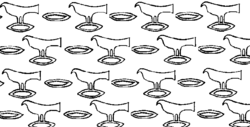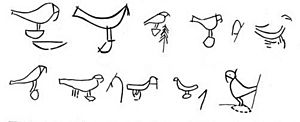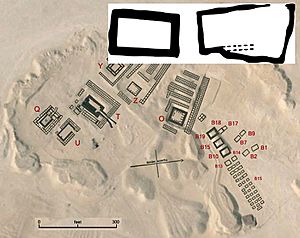Iry-Hor facts for kids
Quick facts for kids Iry-Hor |
|
|---|---|
| Ro, Irj-Hor, Iri(-Hor) | |

Signs r-Ḥr inscribed on a large vessel from the tomb of Iry-Hor, Ashmolean Museum.
|
|
| Pharaoh | |
| Reign | Early to Late 32nd century BC (Dynasty 0) |
| Predecessor | Scorpion I? Double Falcon? |
| Successor | Uncertain, possibly Ka |
| Burial | Chambers B1, B2, Umm el-Qa'ab |
Iry-Hor (also known as Ro) was an early Egyptian ruler who lived around 3200 BC. He was a pharaoh of Upper Egypt before the country was fully united.
For a long time, some experts weren't sure if Iry-Hor was a real king or just a private person. But discoveries in the 1980s, 1990s, and especially in 2012, proved he was indeed a pharaoh. He is now known as one of the earliest rulers of Egypt by name.
Contents
What Does Iry-Hor's Name Mean?
Iry-Hor's name is written using two hieroglyphs. One is the Horus falcon, and the other is a mouth symbol. When his tomb was first found, the name was read as "Ro."
Translating ancient names can be tricky. Some experts think "Iry-Hor" means "Horus mouth." Others, like Werner Kaiser and Günter Dreyer, suggested it means "Companion of Horus."
Another idea, from Toby Wilkinson, is that the name means "Property of the king." Some scholars even thought the symbols might mean "Spokesman" or "Chief." However, most experts now agree he was a king.
How We Know Iry-Hor Was a King
For many years, some historians doubted if Iry-Hor was a true king. But new discoveries helped prove his royal status.
Archaeologists found more than 27 objects with his name on them at Abydos. His tomb there was also very large, like those of other kings.
In 2012, an important inscription was found in the Sinai. This carving showed Iry-Hor's name next to an early symbol for a king. It also mentioned the ancient city of Memphis. This discovery showed that Memphis was founded even before King Narmer, and that Iry-Hor ruled over it.
Because of these findings, most Egyptologists now agree that Iry-Hor was indeed a king. His tomb is similar in size and design to those of later kings like Ka and Narmer.
Iry-Hor's Time as Ruler
Iry-Hor likely ruled just before King Ka, around the early 32nd century BC. He probably governed from Hierakonpolis, a very old city in Egypt. His rule would have included Abydos and the surrounding area.
He also controlled parts of Egypt as far north as Memphis. The inscription in the Sinai shows he visited this important city. Some experts even believe he controlled parts of the Nile Delta in northern Egypt.
Where Iry-Hor's Name Was Found
Iry-Hor was buried in the royal cemetery of Umm el-Qa'ab. This cemetery is where many early kings, including Ka and Narmer, were laid to rest.
His name has been found on many items. These include clay pots from his tomb in Abydos. A clay seal with his name was also found in King Narmer's tomb. In total, over 22 pottery jars and several other fragments with his name have been found in Abydos.
Another similar seal was discovered far north in Lower Egypt, at a place called Zawyet el'Aryan. A carving on a spinning tool found in Hierakonpolis might also refer to him. The rock carving in the Sinai is the furthest north his name has been found. It shows his name on a boat, next to the ancient name for Memphis, "white walls."
Iry-Hor's Tomb
Iry-Hor's tomb is the oldest royal tomb in the Abydos cemetery at Umm el-Qa'ab. It has two separate underground rooms, called B1 and B2. These rooms were first explored by Flinders Petrie in 1899. Later, Werner Kaiser found another room, B0.
These tomb chambers are similar in size to those of later kings like Ka and Narmer. This similarity helped prove that Iry-Hor was a king. No building above ground from his tomb has survived.
Inside chamber B1, pieces of jars with his name carved on them were found. Chamber B2 contained another jar fragment, a seal impression, and writings in ink. Pieces of a bed were also discovered at the site.
See also
 In Spanish: Horus Iry para niños
In Spanish: Horus Iry para niños
- Naqada III, also called Dynasty 0
- Kushim





